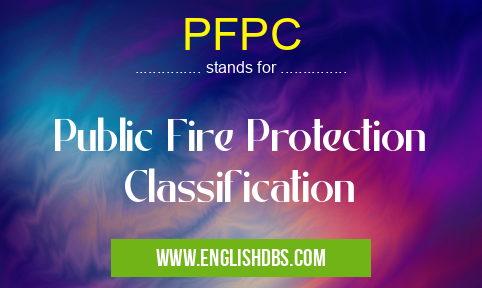What does PFPC mean in FIRE DEPARTMENTS
Public Fire Protection Classification (PFPC) is a system that evaluates and ranks fire protection provided by public fire departments within the United States. It measures the adequacy of personnel, equipment, and water resources available to fire suppression operations in an area. The program was developed by the Insurance Services Office (ISO). The ISO assigns a rating number from 1 to 10, with 1 being the highest score and 10 being the lowest. Ratings are calculated using criteria such as response times, fire safety inspections, training of personnel, water supply systems, dispatch procedures, and more. Ultimately, this system is designed to assess how effectively a fire department can protect a community from potential fires.

PFPC meaning in Fire Departments in Governmental
PFPC mostly used in an acronym Fire Departments in Category Governmental that means Public Fire Protection Classification
Shorthand: PFPC,
Full Form: Public Fire Protection Classification
For more information of "Public Fire Protection Classification", see the section below.
Meaning
Public Fire Protection Classification gives an indication of the level of public protection a community has in place when it comes to fires. This rating is based on factors such as response time, equipment availability, water supply systems, dispatch procedures and training of personnel at the local fire department. Higher rated communities will have access to better trained staff with more advanced equipment at their disposal offering faster response times than those with lower ratings.
Full Form
Public Fire Protection Classification (PFPC) is a system developed by Insurance Services Office (ISO) for evaluating and ranking public fire protection services in the US according to established criteria. PFPC assesses the adequacy of personnel and equipment as well as water resources available for preventing or suppressing fires in an area giving them ratings between 1-10 with 1 being highest score and 10 being lowest.
Essential Questions and Answers on Public Fire Protection Classification in "GOVERNMENTAL»FIREDEPT"
What is Public Fire Protection Classification?
Public Fire Protection Classification (PFPC) is a system that categorizes fire risks in a particular area. It takes into account various factors such as the availability of firefighting personnel, water supply, and other safety measures. The rating is based on the ability of the local fire department to respond quickly and effectively to a fire in the locality.
How is the PFPC rating determined?
The rating is based on a number of factors including the size, type, and condition of buildings in an area, accessibility of hydrants or other water sources for fighting fires, response times and resource capacity of local fire departments, and regulatory requirements for building design, construction materials, and occupancy limits.
How does having a lower PFPC rating affect me?
Having a lower PFPC rating means you live in an area where there are fewer resources available to fight fires. This can mean higher insurance rates since your property may be at greater risk due to insufficient safeguards or protection methods.
Is it possible to increase my PFPC rating?
Yes! By making improvements to your home such as installing residential fire sprinklers or smoke detectors and by making sure your local fire department is aware of any changes you make, you can work towards improved public safety ratings that will benefit everyone in your community.
Does every state have its own version of the Public Fire Protection Classification system?
Not necessarily - many states use the same systems while others may have their own unique versions depending on their regulations. Some states may even use multiple classification systems depending on location or type of building/structure being assessed.
What happens if I am not compliant with PFPC standards?
Non-compliance with public safety standards may result in fines or other penalties from state or local authorities. It’s important to keep up-to-date with regulations so that you don’t face any unexpected costs due to non-compliance issues down the road. Additionally, non-compliance could also put residents at risk if adequate protections aren’t in place in areas prone to fires.
Are certain types of buildings assigned a different PFPC rating than others?
Yes - large buildings such as apartments complexes and high rises typically require higher ratings due to increased complexity when it comes to protection against fires compared with single family homes or small businesses. Additionally some structures such as storage tanks are rated differently than standard buildings due to their specialized nature.
Do I need a special license to evaluate public fire protection classifications?
No - anyone with knowledge about relevant safety codes and regulations can assess public safety ratings for their locality without needing additional certifications or licenses. However it’s important to understand all relevant laws before engaging in this kind of evaluation as incorrect ratings can lead serious legal consequences.
Final Words:
Public Fire Protection Classification provides an overall assessment about how well equipped the local fire department is in protecting its community from potential fires. Although other areas may be prioritized depending on local circumstances or decisions made by town or county governments; having access to adequate levels of public protection could make all the difference during a time of crisis - making PFPC an invaluable tool when it comes to conducting risk assessments.
